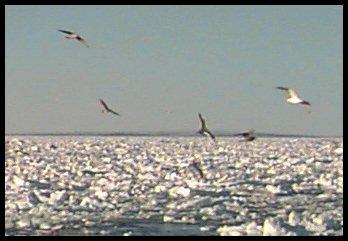
|
|
10 September, 1997
We started to travel south this afternoon and the ice is becoming more
difficult to penetrate. When traveling on a ship in open water the motion
can be very violent but the rhythm of the waves tends to be regular. If
you're not prone to seasickness you can adjust to the movement of the ship.
An icebreaker is a different story, if the boat hits hard ice, it stops and
everything not tied down, flies forward. The noise is somewhat like being
inside a barrel that it is being pounded with hammers. The scraping as the
ice goes by the hull reminds me of a snowplow pushing its blade over dry
pavement. I've taken to wearing earplugs.
The gulls, fulmars, and kitiwakes seem to appreciate our passage. Large
blocks of ice are cracked and often inverted as the ship's hull forces it's
way forward. When this happens, small arctic cod get tossed to the top of
the ice by the turbulence. Small flocks of birds follow the wake of the ship
and are quick to feed on the unfortunate fish. When the cod disappear so do
the birds.
The cod are a keystone species in the arctic. They have been observed in
schools of a billion individuals, providing a food source for birds, harp
seals, ring seals, and whales. The ring seal, which is not a migratory
mammal, has been a staple to the natives in this environment for the past
4000 years.

The gulls catch cod that are thrown onto the ice as the ship passes.
Contact the TEA in the field at
.
If you cannot connect through your browser, copy the
TEA's e-mail address in the "To:" line of
your favorite e-mail package.
|
